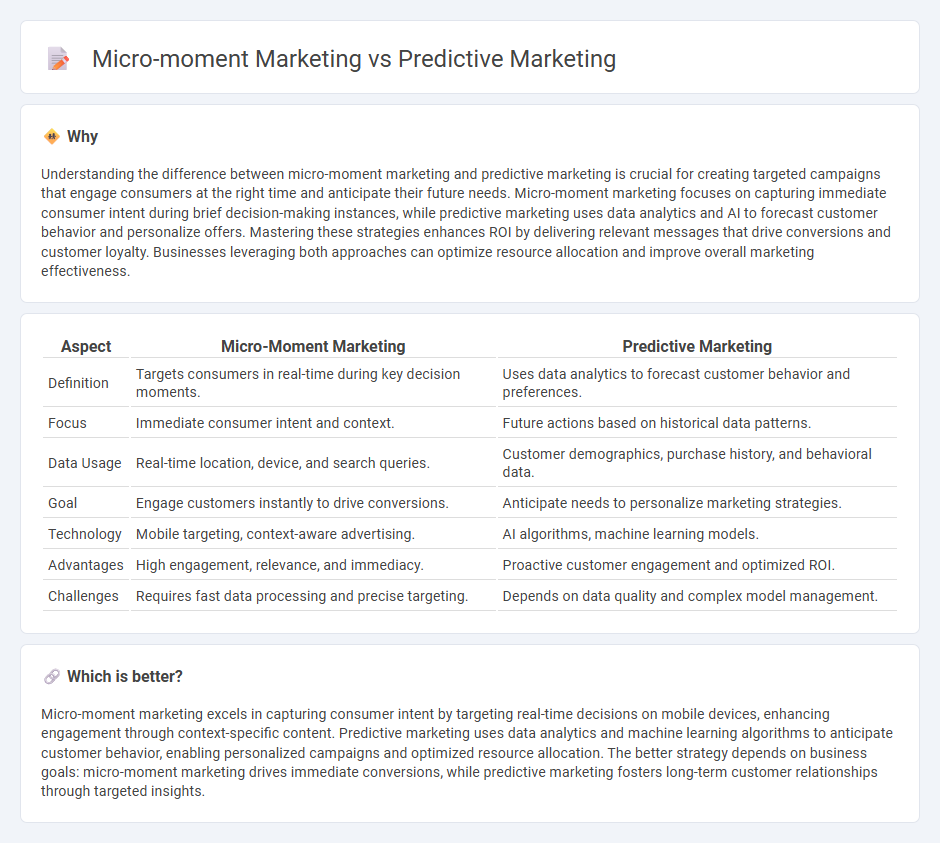
Micro-moment marketing targets consumers' immediate needs by delivering relevant content during critical decision-making instances, while predictive marketing uses data analytics and AI to anticipate future behaviors and preferences. Both strategies enhance customer engagement through personalized experiences driven by real-time insights and pattern recognition. Explore how integrating micro-moment and predictive marketing can elevate your brand's responsiveness and conversion rates.
Why it is important
Understanding the difference between micro-moment marketing and predictive marketing is crucial for creating targeted campaigns that engage consumers at the right time and anticipate their future needs. Micro-moment marketing focuses on capturing immediate consumer intent during brief decision-making instances, while predictive marketing uses data analytics and AI to forecast customer behavior and personalize offers. Mastering these strategies enhances ROI by delivering relevant messages that drive conversions and customer loyalty. Businesses leveraging both approaches can optimize resource allocation and improve overall marketing effectiveness.
Comparison Table
| Aspect | Micro-Moment Marketing | Predictive Marketing |
|---|---|---|
| Definition | Targets consumers in real-time during key decision moments. | Uses data analytics to forecast customer behavior and preferences. |
| Focus | Immediate consumer intent and context. | Future actions based on historical data patterns. |
| Data Usage | Real-time location, device, and search queries. | Customer demographics, purchase history, and behavioral data. |
| Goal | Engage customers instantly to drive conversions. | Anticipate needs to personalize marketing strategies. |
| Technology | Mobile targeting, context-aware advertising. | AI algorithms, machine learning models. |
| Advantages | High engagement, relevance, and immediacy. | Proactive customer engagement and optimized ROI. |
| Challenges | Requires fast data processing and precise targeting. | Depends on data quality and complex model management. |
Which is better?
Micro-moment marketing excels in capturing consumer intent by targeting real-time decisions on mobile devices, enhancing engagement through context-specific content. Predictive marketing uses data analytics and machine learning algorithms to anticipate customer behavior, enabling personalized campaigns and optimized resource allocation. The better strategy depends on business goals: micro-moment marketing drives immediate conversions, while predictive marketing fosters long-term customer relationships through targeted insights.
Connection
Micro-moment marketing and predictive marketing are interconnected through the use of real-time data analysis and customer behavior insights to deliver personalized content at precise moments of intent. Predictive marketing leverages machine learning algorithms to forecast customer needs and preferences, enabling brands to anticipate micro-moments when consumers seek immediate information, products, or services. By combining these strategies, marketers enhance customer engagement and conversion rates through timely, relevant interactions tailored to individual decision-making processes.
Key Terms
**Predictive Marketing:**
Predictive marketing leverages advanced data analytics and machine learning algorithms to forecast consumer behavior and personalize campaigns for higher conversion rates. This approach enhances targeting accuracy by analyzing past purchase patterns, browsing history, and demographic data to anticipate future needs. Discover how predictive marketing can transform your strategy and drive measurable growth.
Data Analytics
Predictive marketing leverages advanced data analytics and machine learning algorithms to forecast consumer behavior and personalize marketing efforts based on historical data patterns. Micro-moment marketing focuses on real-time data insights to target consumers during specific intent-driven moments, optimizing immediate engagement through contextual relevance. Explore deeper strategies in data analytics to maximize the impact of these marketing approaches.
Customer Segmentation
Predictive marketing leverages big data analytics and machine learning algorithms to forecast customer behaviors, enabling precise segmentation based on anticipated needs and purchase patterns. Micro-moment marketing targets real-time consumer intents by delivering hyper-relevant content during critical decision-making moments, emphasizing immediate context over broad segmentation. Explore further to understand how combining these strategies can enhance customer engagement and conversion rates.
Source and External Links
4 Ways Predictive Marketing Can Guide Customer Purchases - Predictive marketing uses data science, including statistical modeling and machine learning, to forecast customer behaviors and personalize marketing efforts such as audience targeting, incentives, and content preferences, enabling businesses to deliver timely, relevant messages that increase purchase likelihood.
Drive Revenue With Predictive Marketing Techniques - Bloomreach - Predictive marketing leverages predictive analytics and AI to analyze historical and current data, helping marketers identify profitable leads, optimize marketing actions, and create personalized responses to forecasted customer behaviors across various business scenarios.
Predictive Marketing: Why You Should Look Into It | Salesforce US - Predictive marketing applies big data and data science to predict which marketing strategies are likely to succeed, influencing a significant portion of total orders and driving personalized recommendations based on customers' past behaviors, as exemplified by companies like Amazon.
 dowidth.com
dowidth.com